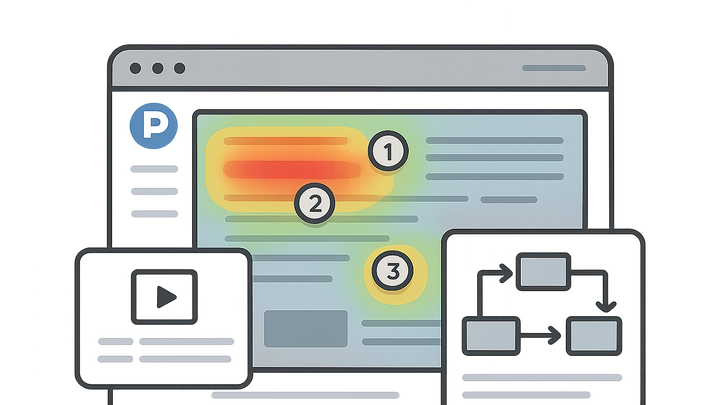Published on 2025-06-29T21:22:05Z
What Is Behavioral Analytics? Examples for CRO, UX, SEO
Behavioral analytics is the practice of collecting and analyzing detailed data on how users interact with a website—what they click, scroll, and engage with—to uncover patterns, pain points, and opportunities for optimization. In the context of conversion rate optimization (CRO), user experience (UX), search engine optimization (SEO), and accessibility audits, behavioral analytics goes beyond pageview counts and bounce rates to reveal the real motivations and frustrations of visitors. By leveraging tools like Prevue.me, teams can generate actionable critiques—ranging from form optimizations to accessibility fixes—that directly tie user behavior to business outcomes like lead generation. This deep dive explores the core concepts, practical implementation, real-world examples, and future trends in behavioral analytics for web professionals.
Behavioral analytics
Behavioral analytics studies user interactions—clicks, scrolls, session replays—to drive CRO, UX, SEO, and accessibility improvements.
What Is Behavioral Analytics?
Behavioral analytics focuses on tracking and interpreting individual user actions—such as clicks, scroll depth, and navigation paths—to understand how people actually use a site. Unlike traditional analytics that emphasize aggregated metrics (pageviews, bounce rates), behavioral analytics reveals the ‘why’ behind those numbers, allowing teams to pinpoint friction and opportunity.
-
Definition and scope
Behavioral analytics measures the sequence and frequency of user interactions to craft a detailed map of on-site behavior. It captures context-rich events that help differentiate intent-driven clicks from random ones.
- Behavior vs. traditional analytics:
Traditional analytics report what happened (e.g., 500 pageviews), while behavioral analytics explains how and why users navigated your site.
- Behavior vs. traditional analytics:
-
Key metrics
Common behavioral metrics include heatmaps, session recordings, and user flow diagrams. These metrics help visualize engagement hotspots and identify drop-off points.
- Heatmaps:
A visual overlay showing where users click, move, and scroll most frequently on a page.
- Session recordings:
Video-like replays of individual user sessions that reveal hesitation, errors, and navigation loops.
- User flows:
Diagrams that chart the most common paths users take from entry to exit.
- Heatmaps:
Why Behavioral Analytics Matters in CRO/UX/SEO/Accessibility
Understanding user behavior is critical to optimizing every aspect of a website. Behavioral insights drive more informed A/B tests, refine user journeys, enhance search visibility, and uncover accessibility barriers that might otherwise go unnoticed.
-
Conversion rate optimization
Identify form drop-offs, confusing CTAs, and funnel leaks by analyzing the exact points where users abandon key actions.
-
User experience enhancement
Spot interface pain points—like unexpected pop-ups or hard-to-find buttons—to streamline navigation and reduce frustration.
-
Seo improvements
Correlate behavioral signals (dwell time, scroll depth) with search rankings to optimize page layout and content placement.
-
Accessibility insights
Detect where assistive-technology users struggle—e.g., keyboard navigation traps—by reviewing session recordings and click paths.
Implementing Behavioral Analytics
A successful behavioral analytics setup requires selecting the right tool, installing tracking, and ensuring compliance with privacy regulations. Here’s how to get started.
-
Choosing the right tools
Select a platform that offers heatmaps, session replays, and automated critiques. prevue.me, for example, provides specialized CRO, UX, SEO, and accessibility insights in one dashboard.
-
Setting up tracking
Embed a small JavaScript snippet across your site to start capturing user interactions in real time.
- Example snippet:
<script src="https://prevue.me/track.js" data-api-key="YOUR_API_KEY"></script>
- Example snippet:
-
Ensuring data privacy and compliance
Collect behavioral data responsibly by honoring user consent and adhering to regional regulations.
- Gdpr compliance:
Implement explicit consent banners and store only anonymized behavioral events for EU visitors.
- Ccpa compliance:
Provide opt-out mechanisms and clearly document how user data is processed and deleted.
- Gdpr compliance:
Real-world Examples with Prevue.me
prevue.me transforms raw interaction data into prioritized, actionable critiques. Below are real examples of how teams have leveraged behavioral analytics to drive results.
-
Case study: lead generation form optimization
A B2B software company used prevue.me to identify that the phone-number field caused 30% drop-off. By making it optional and adding inline guidance, submissions rose by 18%.
-
Interpreting the dashboard
prevue.me’s dashboard organizes insights by impact and effort, helping teams focus on high-ROI fixes first.
- Funnel view:
Shows step-by-step completion rates and pinpoints the biggest leaks.
- Heatmap view:
Highlights high-engagement zones and ignored elements.
- Funnel view:
-
Actionable critiques in practice
Customized recommendations—like relocating CTAs or simplifying navigation—are delivered alongside screenshots and session clips for clarity.
Best Practices and Common Challenges
While powerful, behavioral analytics must be managed carefully to yield reliable insights. Here are tips and pitfalls to watch for.
-
Ensuring data quality
Verify tracking covers all user segments and devices evenly; filter out internal traffic and bots.
-
Contextualizing user behavior
Combine quantitative findings with qualitative feedback—like surveys—to understand the motivations behind actions.
-
Integrating with other analytics platforms
Merge behavioral insights with Google Analytics or GA4 data to build a full picture of user journeys and attribution.
Future Trends in Behavioral Analytics
Behavioral analytics continues to evolve, driven by advances in AI, cross-device tracking, and real-time personalization.
-
Ai-driven predictive modeling
Machine learning models forecast user actions—such as likelihood to convert—enabling preemptive optimizations.
-
Cross-device & cross-channel tracking
Unified analysis of mobile, desktop, and in-app behaviors will deliver seamless, omni-channel user insights.
